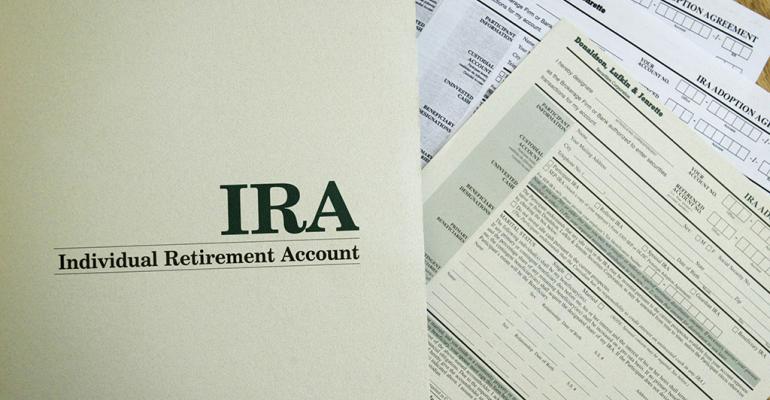In Private Letter Ruling 201943020 (released Oct. 25, 2019), the Internal Revenue Service considered the tax implications of a trustee-to-trustee transfer between individual retirement accounts in which the transferor IRA was established by a then-deceased individual for a charitable organization’s benefit, and the charitable organization created the transferee IRA as an inherited IRA for its own benefit. The PLR serves as an example of “substance over form” analysis and further clarifies the rules concerning inherited IRAs when nonindividual beneficiaries are involved.
Background and Requested Rulings
During life, the decedent established an IRA (original IRA) and named a charitable organization (taxpayer) as its beneficiary. After the decedent’s death, the taxpayer submitted the ruling request, claiming that the original IRA’s custodian required the taxpayer to create a new IRA (transfer IRA) to which all of the original IRA’s assets would be contributed in a direct, trustee-to-trustee transfer. This, it was represented, was required by the custodian before it could distribute assets—ultimately from the original IRA—to the taxpayer. The taxpayer submitted the necessary paperwork to establish the transfer IRA as an inherited IRA. Within that paperwork, the account funding provisions provided that only IRA beneficiaries who were listed at the decedent’s death could transfer amounts to the transfer IRA, and the disclosure statement explained that no contributions of any kind could be made to the transfer IRA. The taxpayer also represented that the custodian required that the transfer IRA be in the taxpayer’s name as its owner and using the taxpayer’s tax identification number.
The taxpayer requested three rulings; namely: (1) whether the transfer IRA was an IRA under Internal Revenue Code Section 408; (2) whether the transfer IRA was a taxable trust; and (3) whether a distribution from the original IRA to the transfer IRA would be subject to federal income tax. (In truth, six rulings were requested in total, but the Internal Revenue Service declined to rule on three based on Section 6.06 of Revenue Procedure 2019-1 (providing that IRS: (1) ordinarily doesn’t issue letter rulings if ruling request doesn’t address requester’s tax status, liability or reporting obligations; and (2) won’t issue letter rulings or determinations regarding hypothetical situations or alternative plans of proposed transactions).)
Transfer IRA Met Requirements
In response to the first requested ruling, the IRS ruled that the transfer IRA met the requirements for qualifying as an IRA under IRC Section 408. In so ruling, the IRS reasoned that the transfer IRA was, in substance, a mere continuation of the original IRA and wasn’t, therefore, established or maintained by the taxpayer as a new IRA for taxpayer-funded contributions. With respect to the original IRA, the ruling noted that, after the decedent’s death, a beneficiary is the person for whose benefit the original IRA is maintained; hence, in practice, the beneficiary’s tax ID often becomes associated with the account to facilitate the reporting of distributions.
The ruling further emphasized the fact that the original IRA didn’t suddenly lose its status as such simply because it was maintained for a charitable organization’s benefit as the decedent-designated beneficiary. By comparison, the ruling noted, the transfer IRA likewise didn’t fail to qualify as an IRA under Treasury Regulations Section 1.408-2(a) simply because it was maintained for a charitable organization’s benefit as the decedent’s intended beneficiary. The IRA custodian aptly required that the paperwork establishing the transfer IRA clearly identified it as the kind of IRA that a beneficiary holds after a specified individual’s death. Hence, the account didn’t fail to continue to qualify as an IRA simply because the custodian’s paperwork and statements suggested that the taxpayer was the “owner” of the transfer IRA and linked it to the taxpayer’s tax ID.
In addition, the ruling continued, the transfer IRA didn’t fail to be recognized as an IRA under Section 408 because it purportedly failed to meet Section 408(d)(3)(C)(ii)’s definition of an “inherited IRA.” In dismissing this claim, the ruling reasoned that Section 408(d)(3)(C)(ii)’s definition was intended to be limited in its application and was only meant to prohibit certain individuals from performing IRA rollovers, an act that other IRC provisions already forbade nonindividual beneficiaries from pursuing. Because a more explicit provision would’ve been superfluous and there was nothing else in Section 408(d)(3)(C)(ii) to suggest that an account failed to qualify as an IRA if it didn’t meet its definition of “inherited IRA,” and since Treas. Regs. Section 1.408-2(b)(8) specifically included nonindividuals as permitted IRA beneficiaries, the IRS dispatched with the claim that the transfer IRA couldn’t qualify as an IRA under Section 408 based on Section 408(d)(3)(C)(ii)’s definition of “inherited IRA.”
Transfer IRA Wasn’t a Taxable Trust
In response to the second request, the IRS ruled that the transfer IRA was exempt from taxation under IRC Section 408(e)(1) and, therefore, that it wasn’t a taxable trust, because the transfer IRA met Section 408’s requirements. This ruling was based on the taxpayer’s representations and the IRS’ assumptions and findings with respect to the first requested ruling (as discussed above).
Original-IRA-to-Transfer-IRA Distribution Wasn’t Taxable
In response to the third request, the IRS ruled that a direct trustee-to-trustee transfer of assets from the original IRA to the transfer IRA was a nontaxable distribution where both IRAs were maintained for the benefit of the same charitable organization (as a beneficiary of the decedent). This ruling was based on Revenue Ruling 78-406, which provided that a trustee-to-trustee funds transfer between IRAs maintained for the same individual’s benefit wouldn’t be deemed a taxable distribution.
Stephen Putnoki-Higgins is an attorney in the private client services practice group at Shutts & Bowen LLP, in Tampa, Fla., and is admitted to practice in Connecticut, Florida and New York.





